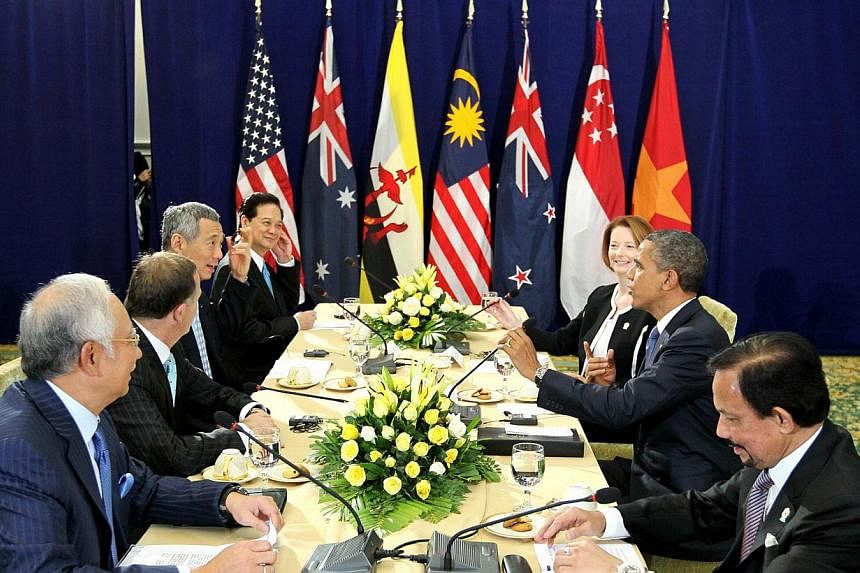Some business analysts are stressing that the pending Trans-Pacific Partnership (TPP) between the United States and 11 other countries promises smaller rewards - if also fewer risks - than previous multilateral efforts to liberalise trade.
But such a judgment omits altogether the national security reasons for finalising both the trade pact and the Trade Promotion Authority that would strengthen the role of the US President in advancing regional commerce.
First, the TPP would help to reverse the impression that the US is a declining and one-dimensional military power. Whatever the image of US power in North America, Asia-Pacific countries continue to harbour considerable doubt about American staying power and strength relative to a rising China. Even our closest allies in the region are enhancing their economic and development ties with China. At the same time, they and others fear what continued US military dominance could bring to the region in dealing with the increasing tension among major powers.
A multilateral trade pact accentuates the dimension of US power and interest that appeals to all actors in the Asia-Pacific region. In Asia, trade is the coin of the realm. The TPP rebrands America as a leading market power, rather than just a security guarantor that brings big guns to settle local disputes. In addition, the TPP bolsters a model of sustainable economic growth that is essential to maintaining our long-term security posture, both with respect to defence spending and forward military presence.
Second, the Pacific trade pact would do more to reassure our key allies than simply tinkering on the margins of our military presence. Our presence is vital. But if we want to signal that we are serious about being a permanent Pacific power, then long-term trade frameworks are more compelling. Despite our military activity, Japan and Australia remain anxious about our future intentions.
That is not good, given how important these allies are. Indeed, Australia is becoming increasingly important for rotational presence and exercising, and the only other country beyond Japan and South Korea where we can imagine being prepared to conduct "Phase 2" combined operations designed to "seize the initiative".
The converse of reassurance would be an action - or in this case, inaction - that would sow great doubt on American credibility. The failure to complete this trade pact would strike a serious blow to our reputation, and one from which it would be difficult to recover.
The TPP anchors our future interests in the region that speaks to Tokyo, Seoul, Canberra and others worried about US power and purpose in the wake of events such as the protracted post-9/11 diversion or the impact of the 2008 Lehman Brothers' bankruptcy on regional calculations.
A third and related national interest in completing the TPP is that it would allow the US to entrench itself in the world's most dynamic world and thereby reach out to new partners in non-military ways. This simultaneously enables such new engagement and lowers the transaction costs on our security cooperation throughout the region.
Importantly, among the other initial stakeholders in the TPP are three of the four South-east Asian countries with disputed claims in the South China Sea. The fourth, the Philippines, is already a treaty ally of the US. But with this trade pact, the US would be able to tighten cooperation with Vietnam, Malaysia and Brunei without having to focus exclusively on maritime defence issues. In addition, the TPP would also solidify US ties with Chile and Peru, two key South American economies with a Pacific orientation. Thus, we can expand our regional partners while underscoring our broad Pacific role.
Fourth, the TPP gives us leverage in the decade ahead as we begin negotiations on second-round entrants. This could be a major tool for engaging China, given that our clear objective is to integrate a rising China, not to contain it.
It also gives us a potential tool for managing Taiwan, whose growing dependence on the mainland is leaving it little international space for avoiding coercion.
Other allies, notably South Korea, would like to join, and ought to be at the front of the queue. The US-Thai alliance has been undermined by political instability in Thailand, and trade may provide a path toward alliance renewal. Finally, other key regional actors, especially Indonesia, could be prepared for admission in a second round, making the TPP a dominant trade framework for the region.
Fifth, a regional trade pact would preserve and adapt a largely US-created regional architecture as we compete to shape the 21st century global order.
What we want is what all nations in the region should want: namely, unfettered access to trade and the global commons.
The TPP would reinforce a regional coalition around common high-standard trade norms and rules, and thereby balance against alternative rule sets that, for instance, favour state-owned enterprises.
The aim is not US primacy so much as the primacy of a rules-based system.
For all of these reasons, beyond the obvious economic ones of expanding trade in relatively new sectors as well as services, the TPP is squarely in the national security interest of the US and the Asia-Pacific region.
The writer is Senior Director of the Asia-Pacific Security Program at the Center for a New American Security, a Washington DC-based think tank.

